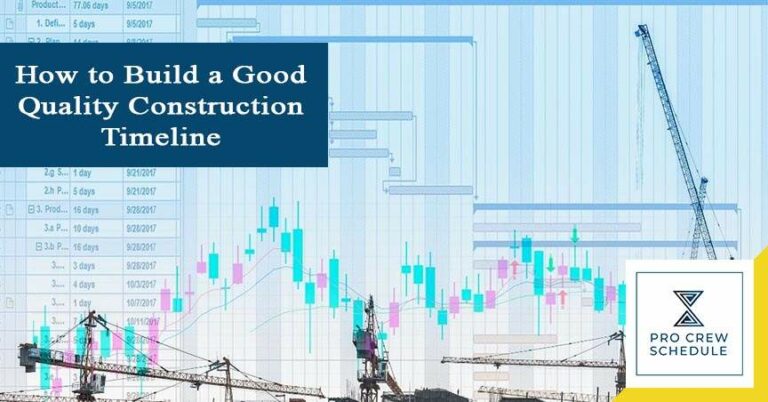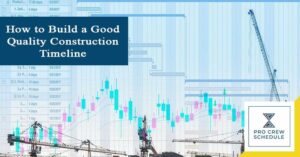If you have been managing construction projects for a while now, you know that the industry is well-known for being prone to many delays. These construction delays vary from project to project and are often due to the following: change orders, inclement weather, financial difficulties, labor shortage, miscommunication, and mismanagement – to name a few. However, keeping the project on track and delivering it on the dot is essential to its success.
For years, construction project managers have struggled with keeping the project free from delays. Sometimes, you might feel pressured if your client wants you to finish a specific task in a short amount of time. Yes, it can be overwhelming and can lead to missed deadlines, messy workspaces, and forgotten tasks the can lower your workforce productivity. However, this can be solved by creating a good quality timeline during the early stages of the project. It is an important method that can help you to strategize on how to manage the project.
Simply put, a timeline is a list of the chronological order of activities or tasks for an entire project. The construction manager can monitor the overall status of the project and be able to strategize accordingly.
In this blog, we’ll let you in on a few tips and tricks that will aid you in creating your timeline efficiently.
8 Things to Incorporate in a Construction Timeline
For your smooth-sailing project management of construction, it is essential to consider the following eight factors when creating your timeline to make sure that everything is accounting for.
1. Define Your Project Scope
Your project scope essentially determines the extent of your work as specified by the client. This should include the following items that the client expects to see once the project is complete and delivered.
- Construction Plans and Activities
- Material and Labor Specifications
- Resources and Inventory
- Project Cost and Budget
- Total Project Duration
- Construction Daily Report
Let us take this as a simple example; one client contracts you to build a house. Your scope would look something like the following: a 200sqm 2-story, three-bedroom house with gray stucco finish, stone cladding, and concrete roof tiles.
2. Generate the Work Breakdown Structure (WBS)
Once you have defined your project scope, the next step would be to create your work breakdown structure. Break down your project scope by listing down all the main activities called work packages.
Using the example above, your WBS would include the following:
- Planning and Administration
- Substructure Construction
- Superstructure Construction
- Finishing
- Utilities
- Project Turnover
3. Itemize the Activities into Tasks and Subtasks
Next, break down your work packages further into tasks and subtasks. In this step, you now probably have an idea of how the construction workflow is going. Specify all the tasks necessary to finish the work package.
Let’s use the substructure construction in the previous section as an example. For substructure construction, you will need to consider all activities required to finish the package. Be sure to consider everything and not miss out on a single task.
Work Package: Substructure Construction
Tasks and Subtask:
Lot Survey and Clearing
Marking of House Layout
Excavation
Preparation for Founding Pouring
- Reinforcement Bars Fabrication
- Gravel Bedding
- Soil Hauling
5. Foundation Pouring
6. Request for Concrete
4. Determine the Activity Sequence
The activity sequence shows you the relationship of activities from one another. For any project you may encounter, some tasks cannot start when their predecessor activities are not yet done. You will also need to specify the critical activities of the project. They will be the ones to watch out for as they are the ones that can affect your timeline once delayed.
Mapping out the sequencing can be a little complicated, especially if you got lots of activities to do for your project. Some tools to make this easier for you to visualize are flowcharts, diagrams, or a construction scheduling app.
5. Estimate the Duration for each Activity and Tasks
Next up, estimate the duration of each activity. Do not forget to add contingencies for possible delays like inclement weather to provide the schedules accurately. Consider also all your resources, labor, and material lead times.
6. Plan Out your Resources and Inventory
Probably the most daunting task for a project manager is construction crew management. In this step, you will need to assign the job for a specific person or a specific group based on their specialties and skills to utilize your resources.
If you have a labor shortage for a specific job, like painting – for example, then you might have to delay the project for a few days. It is a bit risky to replace a painter with a masonry worker. It might compromise the quality, and workmanship issues may arise.
You will also need to plan out when you should be ordering the materials or your inventories and when you will need these. Suppliers often impose a lead time on the deliveries – especially if the materials are fast-moving. Using inventory management software can help you to monitor these and prevent delays.
7. Specify The Project Milestones
Milestones essentially help you track the progress of the project. It essentially acts as a baseline to see how your project is doing. They represent a point in your timeline where significant progress or scope has been achieved. Through this, you can identify your project’s percentage of completion.
8. Build your Timeline
Now, you have prepared all the necessary needed to build a good quality timeline. Many platforms can help you do this, from graphs, Gantt charts, or construction scheduling software.
As we discussed earlier, our industry is prone to delays, so there are no timelines assumed to be set in stone. The key here is to monitor and review your schedule to see the status and any potential problems.
Improved Communication Between All Parties
Having a timeline helps you ensure that everyone is on the same page. Everyone in the team can see where the project is supposed to be as there is a clear and concise work path. This also prevents any possible miscommunication between the office and the site through enhanced team collaboration.
Better Cost Control and Cost Monitoring
As everything is laid out in a single file, you should see and monitor what you should be spending on and where you should be controlling the budget. This helps you prevent going over the budget and minimize wastage.
Enhanced Quality Control and Quality Assurance Construction
Easily spot out any impending problems and solved them immediately to prevent any damages to the project. This way, we can stop any material mistakes or defects when we deliver the project to the client.
Improved Workforce Productivity
Using a timeline, you can map out when you will need a specific skill or specialty in the project to help you chose the right person for the right job.
Better Project Monitoring and Management
Now, project managers can monitor their projects better and more efficiently. Everything is laid out in a single timeline, from activities that need to be focused on or allocate more resources. You can make strategies and decisions based on the data that you are seeing.
How Can Construction Scheduling Software Help You With Your Timeline?
With all the technology available nowadays, it is no wonder why most contractors turn to online software to help them in managing construction projects. Here are some ways why having construction scheduling software can help you too:
A Centralized Space
Every aspect of the project can be accessed online by anyone from the project team. Every necessary detail of the project is included, and documents can be uploaded, as well.
Real-Time Updates
This can be done by doing a construction daily log to check what items were accomplished for the day, week, or month. Here, we will be able to see the progress of the project for a specific time frame.
Inventory Management
Having an online inventory software helps you to track the status of your materials easily:
- When should you replenish your stock items?
- How many materials are remaining on-site?
- When should the items be used in the project?
- Are any defects in the supplier delivery?
Crew Management
Scheduling tasks used to be one of the most feared tasks of a project manager. Using scheduling software, you will see if a worker is overloaded or underloaded with workloads and adjust accordingly. You will be able to see which activities needed more labor as well.
Time Management
Now, you can manage the duration of each activity, ensuring that nothing takes beyond your set timeline. You can monitor if the scope of work needs a new plan of action to guarantee its timely completion.
Key Takeaway
Creating a construction timeline when you are set to handle a new construction project is essential to its success. By considering all data required, you can monitor and strategize your way into managing your project to ensure its timely delivery to the client and exceed expectations.







